Fix: Taskbar Disappeared on Windows 10
The taskbar is a very useful UI element in Windows. But, a lot of users are experiencing a problem where their taskbar is missing from the Windows. There are multiple scenarios and settings that cause the taskbar to disappear. Some users had their taskbar working fine and set to auto-hide when the problem started happening. For these users, their taskbar went into the hidden mode and never reappeared, even after they hovered the mouse over it.
Other users had their taskbar set to always appear but all of a sudden it was gone and nothing makes the taskbar reappear again. Although it wasn’t common, but some users experienced this issue of missing taskbar only when using certain applications like Google Chrome in the full mode. For them, the taskbar was working fine until they used the full-screen mode and the taskbar never reappeared even after they were out of the full-screen mode.

What causes your taskbar to disappear?
There are several things that can cause your taskbar to disappear but none of them are caused by a problem or bug in the system. Most of these are either settings issues or accidental clicks. So, here are the things that can cause your taskbar to disappear.
- Accidental Clicks or Resize: The most common cause of missing taskbar are accidental clicks or key presses. There aren’t any shortcut keys for your taskbar but there are keys like F11 that brings your screen to the full-screen kind of mode that doesn’t show the taskbar. Accidentally clicking one of these keys will cause this issue. This issue can also be caused by accidental resizing. Not a lot of users know that the taskbar is resizable. Its height can be resized to 0 which might lead people to think that the taskbar is gone.
- Explorer.exe or Windows Explorer: Windows Explorer can also cause this issue and, in fact, it is one of the most common causes of this issue. Although we aren’t exactly sure why it causes the issue but sometimes Windows Explorer causes the taskbar to hide or remain hidden. Simply restarting the Explorer.exe or Windows Explorer from the task manager resolves the issue.
Note
- If you are having troubles in performing the basic Windows tasks then you can try to open the taskbar via the Windows key. The Windows key opens up the start menu. So, try to press the Windows key once and check if it opens the start menu or not. If it opens the start menu then you will most likely be able to see the taskbar. Simply right-click the taskbar and select Taskbar properties. You can turn off the auto-hide option of the taskbar and various other settings to see which one works best.
- Click F11. F11 key brings your view to full-screen mode and hides everything else especially the taskbar. The taskbar won’t appear as long as you are in this mode. So, clicking F11 once again will take you out of this full-screen mode.
- Sometimes the issue is simply with the settings. You (or someone else) might have accidentally changed the settings of the taskbar. The taskbar has an auto-hide feature. If you aren’t familiar with this feature and you haven’t tried hovering your mouse on the bottom of your screen then try that. You can change the auto-hide feature by right-clicking the taskbar > select taskbar properties > toggle off auto-hide.
Method 1: Restart Explorer.exe
Restarting the explorer.exe process from the task manager seems to fix the issue for the majority of the users. It isn’t a permanent solution though, you will have to repeat the process every time your taskbar disappears. So, keep that in mind.
- Press and hold CTRL, SHIFT, and Esc keys simultaneously (CTRL + SHIFT + ESC). This will open the task manager
- Click the Processes tab (it should already be selected and opened) if it isn’t opened already.
- Locate a process named Explorer.exe. Right-click and select Restart.
Note: You might see this named Windows Explorer in some version of Windows. So, Windows Explorer and Explorer.exe are the same processes.

Your issue should resolve once the explorer is restarted.
Method 2: Resize the Taskbar
The taskbar is resizable. You can grab the taskbar from the top line and drag up or down to change its size. It is often the case where users accidentally reduced the size of the taskbar to just 1 or 0 lines. In this case, the problem isn’t caused by a bug or a setting but rather because of an accidental resize. Simply resizing the taskbar back to its original size will fix the issue. Follow the steps given below to resize the taskbar.
- Close all the applications and open the Desktop screen. This is to make the screen clear and not click any open applications.
- Hover your mouse at the bottom of the screen, where your taskbar might have hidden itself. You should be able to notice your cursor change into 2 sided arrowhead (the icon that appears while resizing the windows).
- Once you notice the cursor change to the resizing icon, left click and drag the mouse upwards.

This should bring the taskbar above the 0 line height and you should be able to see the taskbar.
Note: If you don’t want this to happen again in the future, right-click the taskbar and click the option Lock Taskbar. This should lock the taskbar at its position and it won’t allow you to resize or change the position of the taskbar. Right-click your taskbar again and now you should be able to see a tick beside the Lock Taskbar option. This indicates that the taskbar is locked. If you find yourself in need of changing the location or size of your taskbar then simply repeat these steps and it should unlock the taskbar.




